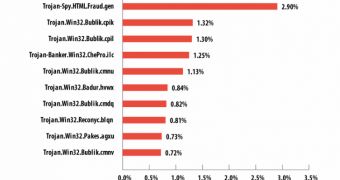In the month of May, the amount of fake email decreased by 1.3% compared to April 2014, but the prevalent attack type was still phishing, followed by strains of a ZeuS/Zbot dropper.
The average weekly spam percentage for the month of May was 69.8%, according to a report from Kaspersky security firm. In the third week of the month, the amount of spam email increased to 72.1%.
Spammers attempted to take advantage of all the important events, and the celebration of Mother’s Day was the perfect opportunity to make some money by luring victims with discount promises. The URLs provided in the message body directed to freshly created domains, different from what was advertised in the email.
Gardening hobbyists were also targeted, with offers for seeds for lawns, flowers and fruits that led to domains created less than a week before.
Other ways to attract victims included advertisements for distance learning programs and even for getting the degree (honorary doctor) by making a donation to a church.
However, the largest percentage of the fake emails contained malicious programs, and Kaspersky detected Trojan-Spy.HTML.Fraud.gen as the prevalent threat in a top ten list, blaming it for almost 3% of the spam cases.
“This threat appears as an HTML phishing website and sends email disguised as an important notification from banks, online stores, and other services,” says the report.
Five variants of the Bublik malware family were also detected, with a combined presence of 5.29%. They are designed to infect the victim’s computer with infostealing software targeting banking details.
Some Bublik versions are known to download the ZeuS/Zbot malware, which, apart from stealing banking credentials, is known to distribute the CryptoLocker ransomware.
Based on the detections made by Kaspersky, UK recorded the largest number of email threats, accounting for 13.5%, ahead of the U.S. (9.9%) and Germany (8.2%).
As far as phishing is concerned, the company says that “email search sites (32.2%) topped the rating of organizations most frequently targeted by phishers with a slight growth of 0.5 percentage points from the previous month. Second came Social networks (23.9%), headed by Facebook. Financial and payment organizations were in third place with 12.8% (+0.2 percentage points).”
The slight decrease in May should continue in June, as the vacation season approaches and scammers also take a break from their activities. However, Kaspersky notes that an increase in the fake emails purporting tourism services and offers for vacation destinations is to be expected.

 14 DAY TRIAL //
14 DAY TRIAL //